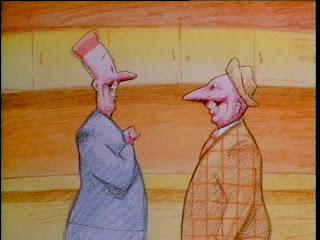Figure 1, (2008), How to Kiss
Figure 2, (2009), The Tune
Bill Plympton began his cartooning career by creating cartoons for publications such as the New York Times and Playboy. He then went on to produce his first feature films in the style of surreal musical fantasy with inspired animation. "It's quintessential Plympton in that it has a hand-drawn look that emphasizes pencil lines and shading, and it offers up somewhat disturbing absurdest humour that relies on the extreme plasticity of form that only animation can deliver. Plympton is an animator's animator not only because his drawings are magnificent (and magnificently weird), but because he plays the medium for all that it is worth-Plympton's odd and hilarious vision of reality can only be expressed via animation." (Mancini, 2009) Plympton's technique allows a controlled form of how the characters can be exaggerated as if the have a clay feel, able to be morphed and merged to produce disgusting and disturbing forms.
Figure 3, (2011), The Tune 2
Plympton has expressed dark humour in his animations allowing him to exaggerate on serious themes and turn them into something twisted. "Plymptons, dating back to the physiognomy transmutations of 1987's "Your Face", "have always relied on sudden eruptions of sex and violence to elicit audience response." (Staff, 2008) the evidence states how Plympton has taken issues that a viewer would probably find serious in the real world and tend to avoid but in the animations it is appropriate because of the style and light heartiness of the performance. The exaggerations gives the viewer an idea of the emotions that Plymptoon was trying to communicate as in 'The Tune' that reveals two characters separated with the man's successful to write a new hit and become successful and in the process meets a range of unusual characters that have some back story of how they have ended up or where they see themselves going which inspires the main character to see the world different and causes the audience to sympathize with him. "Plympton goes for mood over sight gags, which gives his fans an idea of his range. As an '80's time capsule, the live action portions of the video itself are absurdly amusing." (Lineberger, 2006) The quote picks up on 'mood over sight gags' so basically Plymptoon tries to draw his comedy from emotion and how we hear and feel instead of the obvious.
Figure 4, (2007), Guard Dog
Figure 1, (2008), How to Kiss, @ http://www.plymptoons.com/biography/anishorts.html, Accessed on: 2003
Figure 2, (2009), The Tune,@ http://www.taringa.net/posts/tv-peliculas-series/2003996/The-Tune---Bill-Plympton.html, Accessed on: 13th January 2009
Figure 3, (2011), The Tune 2, @ http://hotfileserve.com/tune-extras-1992-dvd5-641745/, Accessed on: February 2011
Figure 4, (2007), Guard Dog, @ http://www.body-pixel.com/2009/07/22/pocket-cinema-bill-plympton-short-films/, Accessed on: 22nd July 2009
Bibliography
Lineberger Rob, (2006), DVD Verdict - Plymptoons, @ http://www.dvdverdict.com/reviews/earlyplympton.php, Acessed on 28th April 2008
Mancini Dan, (2009), Bill Plymptoon's Dog days, @ http://www.dvdverdict.com/reviews/dogdays.php, Accessed on: 23rd July 2009
Staff Variety, (2008), Film Reviews - Idoits and Angels,@
http://www.variety.com/review/VE1117937044?refcatid=31, Accessed on: 6th May 2008







No comments:
Post a Comment